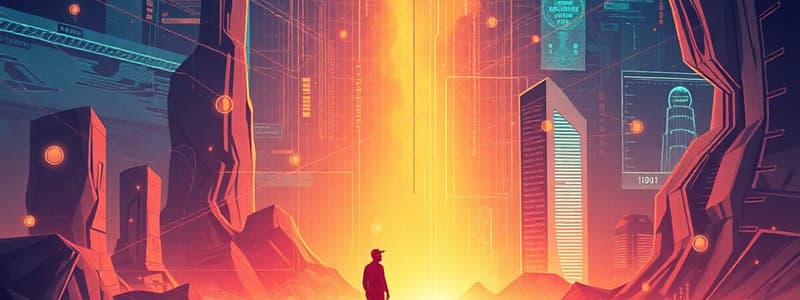Podcast
Questions and Answers
What is one economic impact of information technology on organizations?
What is one economic impact of information technology on organizations?
- Higher capital investment in buildings
- Increased manual labor costs
- Greater reliance on physical documents
- Lower capital and information costs (correct)
How does information technology influence labor roles within organizations?
How does information technology influence labor roles within organizations?
- It increases the demand for middle management
- It eliminates the need for automation
- It promotes traditional job structures
- It leads to labor substitution and decreased clerical roles (correct)
What effect does IT have on organizational structures?
What effect does IT have on organizational structures?
- Reduces the empowerment of lower-level employees
- Flattens organizational structures (correct)
- Results in an increase in managerial layers
- Encourages more hierarchical structures
What advantage does information technology provide in terms of managerial efficiency?
What advantage does information technology provide in terms of managerial efficiency?
How does IT impact transaction costs and firm size?
How does IT impact transaction costs and firm size?
What is a primary organizational change caused by the flattening effect of IT?
What is a primary organizational change caused by the flattening effect of IT?
Which factor does NOT influence organizational resistance to change?
Which factor does NOT influence organizational resistance to change?
How does the Internet benefit organizations in terms of information management?
How does the Internet benefit organizations in terms of information management?
Which of the following is a consideration when planning a new information system?
Which of the following is a consideration when planning a new information system?
In postindustrial organizations, authority is increasingly based on which of the following?
In postindustrial organizations, authority is increasingly based on which of the following?
Flashcards are hidden until you start studying
Study Notes
Economic Impacts of Information Technology
- IT lowers capital and information costs.
- IT alters the capital-labor balance in organizations.
- IT influences business strategies with cost-effective solutions.
- Decreased IT costs lead to labor substitution.
- IT affects roles in middle management and clerical work.
- There’s a shift towards automation and digital solutions.
Organizational and Behavioral Impacts of IT
- IT flattens organizational structures.
- IT leads to fewer hierarchical levels.
- Rapid information dissemination reduces managerial layers.
- IT empowers lower-level employees.
- IT leads to better access to information.
- IT increases managerial efficiency.
Understanding Organizational Resistance to Change
- Information systems become bound up in organizational politics because they influence access to information, a key resource.
- Information systems potentially change an organization's structure, culture, politics, and work.
- Factors influencing organizational resistance to change involve:
- The nature of the innovation
- The structure of the organization
- The culture of the organization
- The tasks affected by the innovation.
The Internet and Organizations
- The internet increases the accessibility, storage, and distribution of information and knowledge for organizations.
- The internet can greatly lower transaction and agency costs.
Implications for the Design and Understanding of Information Systems
- Organizational factors in planning a new system include:
- Environment
- Structure
- Culture and politics
- Type of organization and style of leadership
- Main interest groups affected by the system
- Attitudes of end users
- Tasks, decisions, and business processes the system will assist
Porter's Competitive Forces Model
- Porter's competitive forces model provides a general view of a firm, its competitors, and the environment.
- Five competitive forces shape the fate of a firm:
- Traditional competitors
- New market entrants
- Substitute products and services
- Customers
- Suppliers
Information System Strategies for Dealing with Competitive Forces
- Generic strategies for dealing with competitive forces, enabled by using IT include:
- Low-cost leadership
- Product differentiation
- Focus on market niche
- Strengthen customer and supplier intimacy
The Internet's Impact on Competitive Advantage
- The internet transforms or threatens some industries.
- The internet increases rivalry among competitors.
- The internet enables new entrants into the market.
Smart Products and the Internet of Things
- The internet of things (IoT) involves the use of interconnected sensors in products.
- Smart products include fitness equipment and health trackers.
- Smart products expand product differentiation opportunities.
The Business Value Chain Model
- The value chain model views a firm as a series of activities that add value to products or services.
- The value chain model highlights activities where competitive strategies can be best applied.
Extending the Value Chain: The Value Web
- The value web is a collection of independent firms using highly synchronized information technology to coordinate value chains to produce a product or service collectively.
Synergies
- Synergies occur when output of some units are used as inputs to others, or organizations pool markets and expertise.
Core Competencies
- A core competency is an activity for which a firm is a world-class leader.
Network-Based Strategies
- Network-based strategies take advantage of a firm’s abilities to network with one another.
- Network-based strategies include the use of:
- Network economics
- Virtual company model
- Business ecosystems
Network Economics
- Network economics involves the marginal cost of adding new participants being nearly zero, with much greater marginal gain.
Virtual Company Model
- A virtual company uses networks to ally with other companies to create and distribute products without being limited by traditional organizational boundaries or physical locations.
Business Ecosystems and Platforms
- Business ecosystems are industry sets of firms that provide related services and products.
Studying That Suits You
Use AI to generate personalized quizzes and flashcards to suit your learning preferences.




